|

Hopkins’
Provost Dr. Steven Knapp Selected as GW’s
16th President | W.
Russell Ramsey Named Chairman of Board of Trustees;
2007-08 Officers Elected | Board
Honors Trachtenberg with Endowed University Professorship
| GW Endowment Reaches
$1 Billion | Presidential
Views on Global Affairs | In
Partnership Project, GW Plans New Residence Hall
| GW’s 20-Year
Foggy Bottom Campus Plan Approved | GW
Targets $4.5 Million Toward Academic Excellence
| Standing Strong For
Virginia Tech | Historical
Bank Records Move to GW | Alumna
Marguerite Barratt Named Columbian College Dean
| Jazz Band Showcases
That Swing | A ‘Signature
of Loudoun’ | Colonials
in Congress | Nurturing
the Flock | VA Campus
Hosts High Schoolers | Re-spoutin’
the Fountain | George
Welcomes | GW
in History | A
Faculty for Writing

Hopkins’
Provost Dr. Steven Knapp Selected as GW’s
16th President

|
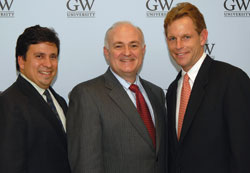
GW Trustee Nelson Carbonell, BS ’85;
GW President-elect Dr. Steven Knapp; and
GW Chairman-elect W. Russell Ramsey, BBA
’81
Jessica McConnell
|
GW’s Board of Trustees has announced its
selection of Dr. Steven Knapp, provost and senior
vice president for academic affairs of The Johns
Hopkins University, as GW’s 16th president.
Knapp brings nearly 30 years of higher education
experience and an impressive record of academic,
fund-raising, and leadership accomplishments.
He will assume office Aug. 1, 2007, succeeding
Stephen Joel Trachtenberg, who will become President
Emeritus and University Professor of Public Service
when his current term concludes in the summer
of 2007.
“Steven Knapp possesses academic and research
expertise, an exemplary fund-raising background,
entrepreneurial spirit, and institutional, civic,
and international leadership abilities that will
help GW achieve the next level of success,”
said W. Russell Ramsey, BBA ’81, chairman-elect
of the GW Board of Trustees and chairman of the
presidential search committee. “The fact
that Steve was the unanimous choice of the search
committee speaks volumes about his credentials,
especially given the tremendous interest in this
position and the outstanding, diverse pool of
candidates. We firmly believe we have found a
very special successor to President Trachtenberg,
one who shares the University’s vision and
who will add to its prestige and reputation.”
Knapp joined The Johns Hopkins University in
1994 as dean of Arts and Sciences and has served
since 1996 as provost. Johns Hopkins is the nation’s
largest research university with $1.5 billion
in federally sponsored research expenditures and
also is Maryland’s largest private employer.
As chief academic officer, Knapp coordinates the
work of the eight Hopkins schools and develops
strategies for regional, national, and international
growth.
Knapp is actively engaged in fund raising, including
an ongoing $3.2-billion capital campaign. His
leadership accomplishments include the establishment
of a university-wide equal opportunity and affirmative
action office, a new fund for “target of
opportunity” professorships, an undergraduate
degree in neuroscience, the Phoebe R. Berman Bioethics
Institute, the addition of an international research
institute to the university’s campus in
Nanjing, China, and a $20-million student arts
center. Also, along with Hopkins President William
R. Brody, he established a Commission on Undergraduate
Education that has resulted in significant new
initiatives in the areas of student life and diversity.
“It’s an honor and a privilege to
assume the responsibilities of president of The
George Washington University,” said Knapp.
“It is also humbling to follow Steve Trachtenberg,
whose leadership during his remarkable tenure
has transformed the GW campus and propelled the
University to international acclaim. GW is now
poised to advance into the first rank of American
research universities and to play a uniquely powerful
role in shaping the future of higher education.
I look forward to working with our entire University
community—faculty, students, staff, trustees,
alumni, and neighbors—in moving the institution
forward, building its academic excellence, and
drawing on its historic strengths and its unrivaled
location in the heart of the nation’s capital.”
While at Hopkins, Knapp expanded the position
of provost and assigned a special priority to
the university’s role in the Baltimore region
and, more widely, in the national and international
communities. He organized an Urban Health Council
to develop an effective university and health
system response to public health problems in inner-city
Baltimore, which resulted in the creation of the
five-year-old Urban Health Institute. During his
tenure, Hopkins created a director of city relations
in its Office of Government Affairs to address
town-gown issues.
Knapp has served for 10 years as the university’s
representative to the Maryland Independent Colleges
and Universities Association Board of Trustees
and frequently testifies before the Maryland General
Assembly. Knapp currently serves on the Maryland
Governor’s Advisory Committee on Mathematics,
Science, and Technology Education, and on the
National Space Biomedical Research Institute board
of directors, and he is chair of JHPIEGO Corp.
Knapp also has been actively engaged in the strategic
planning and lobbying efforts of the Association
of American Universities and has directed international
initiatives, including Johns Hopkins’ expansion
of its institutional presence in Italy, China,
and Singapore.
“Steven Knapp was selected following a
comprehensive national search and we are delighted
with the results,” said Charles T. Manatt,
JD ’62, chairman, GW Board of Trustees.
Manatt offered special thanks to Ramsey and the
members of the search committee; to the many members
of the University community who participated in
the process through task force forums, led by
Trustee Nelson Carbonell, BS ’85; and to
President Trachtenberg for his nearly two years
of “dynamic leadership that has propelled
GW to unprecedented heights and has positioned
the University for an even more successful future.”
President Trachtenberg said, “Over the
years, I’ve talked with thousands of parents
who have expressed the wonderful, yet mixed emotions
attached to sending their children off to college.
I now begin the process of sending my University
off to its next president. Like any proud parent,
I am filled with joy, a little sadness, and a
great sense of satisfaction for all that has been
accomplished to get us to this point. That GW
has attracted a candidate of the caliber of Dr.
Steven Knapp is a testament to our combined efforts
to help GW become one of our truly great institutions
of higher education. I look forward to working
with Steve in the coming months to ensure a smooth
transition. And I look forward to our University’s
future success under his leadership.”
Knapp joined Johns Hopkins after 16 years on
the faculty at the University of California, Berkeley,
where he held many leadership positions in its
Department of English. He is a specialist in 18th-
and 19th-century English literature and literary
theory, has written two books and numerous articles,
and has lectured across the country. He earned
his doctorate from Cornell University in 1981
after receiving a master’s degree there
in 1977 and a Bachelor of Arts degree from Yale
University in 1973. He and his wife, Diane, have
a farm in Sparks, Md. They have two adult children,
Jesse and Sarah.
W.
Russell Ramsey Named Chairman of Board of
Trustees; 2007-08 Officers Elected
On Feb. 9, the GW Board of Trustees elected
W. Russell Ramsey, BBA ’81, chairman
and CEO of Ramsey Asset Management, as its
next chairman. Ramsey will serve a three-year
term starting July 1, succeeding Hon. Charles
T. Manatt, JD ’62, who has served
as chairman for the past six years.
Ramsey is a successful entrepreneur, having
built multibillion-dollar businesses primarily
in the fields of investment banking and
money management. He is most widely known
for co-founding Friedman, Billings, Ramsey
Group, a top 10 investment bank, in 1989.
Ramsey served as president and co-chief
executive officer at FBR through 2001 and
maintains an ongoing role as a shareholder
and member of its board of directors. In
2001, he founded Ramsey Asset Management,
a hedge fund manager based in the Washington,
D.C., area, of which he is chairman, CEO,
and CIO. He also sits on the board of JER
Investors Trust and the National Geographic
Council of Advisors.
Ramsey joined GW’s Board of Trustees
in 1998 and has served as vice chairman
of the board and chairman of the investment
and the real estate committees. He also
has chaired several special committees such
as those for the presidential search and
Square 54. During the past three years,
he has overseen the creation and staffing
of GW’s investment office led by Donald
Lindsey.
In addition to the chairman, the 2007-08
board officers are Vice Chairwoman Lydia
Thomas, who also served as vice chairwoman
of the presidential search committee and
is chairwoman of the Academic Affairs Committee
and president and CEO of Mitretek Systems;
Vice Chairman Nelson A. Carbonell Jr., BS
’85, who also served on the Presidential
Search Committee and is chairman of the
Advancement Committee, chairman of the Task
Force on Advancement, and president and
chairman of Snowbird Capital; Secretary
Patricia Gurne, JD ’69, partner in
Gurne Porter, PLLC; and Assistant Secretary
I. Allan From, BBA ’72, who also is
chairman of the Student Affairs Committee
and shareholder in Howard, Stallings, From
& Hutson, PA. Each member of the executive
committee will serve a one-year term starting
July 1.
Ramsey attended the GW School of Business
on a baseball scholarship and earned his
Bachelor of Business Administration in 1981.
He was a starter all four years and MVP
and captain of the team in his senior year
when he broke the GW record for most stolen
bases in a season. Ramsey was inducted into
GW’s Athletic Hall of Fame in 1995
and was an honorable-mention member of its
All-Century Baseball Team.
Ramsey and his wife, Norma, have given
generously to the GW School of Business’
finance programs and athletic teams. In
2005, the Ramseys donated $1 million to
the University endowment to establish the
Ramsey Student Investment Fund, an investment
portfolio managed by GW MBA students in
the Applied Portfolio Management course.
In addition to the financial gift, Ramsey
and his firm provide research support and
investment expertise to students who are
selected to manage the fund.
Ramsey is a native Washingtonian. He, Norma,
and their four children live in Northern
Virginia. The Ramseys are founding investors
of Venture Philanthropy Partners, which
has invested nearly $70 million in nonprofits
in the D.C. area over the last five years
by helping community leaders build strong
nonprofit institutions. Through the W. Russell
and Norma G. Ramsey Foundation, they have
funded four-year scholarships for the D.C.
Capital Area’s Big Brothers Big Sisters
and supported a variety of philanthropic
causes dedicated to at-risk families. Ramsey
serves on the Virginia Governor’s
Advisory Council on Revenue Estimates and
has served on the Governor’s Commission
on Information Technology, as a trustee
for the Virginia Foundation for Independent
Colleges, and is a founding member of One
Virginia. |
Board Honors Trachtenberg
with Endowed University Professorship
The GW Board of Trustees announced that President
Stephen Joel Trachtenberg will hold an endowed
chair of public service in the School of Public
Policy and Public Administration when he becomes
President Emeritus and University Professor of
Public Service on Aug. 1. Following Trachtenberg’s
retirement, future faculty members named to that
position will occupy this endowed chair—to
be known as the Stephen Joel Trachtenberg University
Professorship in Public Service. Of the $3 million
necessary to endow this professorship, in excess
of $2 million already has been pledged.
“President Trachtenberg has transformed
our University into an academic powerhouse with
the largest endowment of universities in the nation’s
capital, world-renowned faculty, and highly accomplished
students and alumni,” says Charles T. Manatt,
JD ’62, chairman of GW’s Board of
Trustees. “His tireless efforts established
a leadership role for the University in the District
of Columbia and raised the University’s
prestige and reputation around the globe, which
will benefit the GW community for many years to
come.”
“It has been my goal to ensure that George
Washington’s desire to create a world-class
university in the heart of the nation’s
capital became a reality,” Trachtenberg
says. “Today, it is a source of great pride
to know that GW is an economic, political, and
intellectual hub for both greater Washington and
for students, faculty, and partners around the
globe. I believe our namesake would be proud to
see that this is both a center of scholarship
and learning and also a school that embodies his
spirit for public service. I am looking forward
to returning to the faculty to research, write,
and teach, while enjoying fully the First Amendment
freedom of speech.”

GW Endowment Reaches
$1 Billion
GW’s endowment crossed the $1-billion threshold
in December, allowing the University to become
the first institution of higher education in the
nation’s capital to reach the mark. The
endowment has grown nearly $800 million since
President Stephen Joel Trachtenberg joined the
University in 1988. “It is a source of tremendous
pride that this milestone has been achieved on
our watch,” says Charles T. Manatt, JD ’62,
chairman of the GW Board of Trustees.
In 1988, the University’s endowment stood
at approximately $200 million.
“This is a significant achievement for
the University and everyone who has worked so
hard to build this financial foundation, including
Executive Vice President and Treasurer Lou Katz,
Board Chairman Charles T. Manatt, current and
former Investment Committee Chairs Russ Ramsey
and Mike Curzan, and a very dedicated Board of
Trustees,” Trachtenberg says. “Going
forward, our success will depend on our ability
to provide superior educational opportunities,
attract world-class faculty, and continue to provide
state-of-the-art technology and a first-class
living and learning environment. Historically,
GW has relied heavily on tuition. But, tuition
won’t get us there now. We will need to
rely more on endowment. We are at the point where
we can applaud our success to date, while emphasizing
the need to keep driving forward on all fronts.
Only a firm financial foundation will allow the
University to remain flexible and first rate.”
The recent surge in GW’s endowment comes
predominantly from investment gains, as well as
gifts. During the 2006 fiscal year (July 1, 2005-June
30, 2006) the GW endowment produced a 19.7 percent
return, investment earnings of $159 million, and
received more than $20 million in gifts and other
transfers, bringing its total market value to
$963.6 million as of June 30, 2006. GW’s
endowment increased by more than $55 million net
of spending in the first six months of the 2007
fiscal year, resulting in its current $1 billion-plus
market value.
For all of its successes, GW still lags behind
peer institutions in two important measures: endowment
funds per student and the percentage of operating
budget financed by endowment funds.
In the past three years the market value of GW’s
endowment has increased by more than $325 million.
During that timeframe, nearly $110 million has
been distributed from the endowment to support
University activities. Endowment distributions
provide support for scholarships, fellowships,
academic and research programs, libraries, and
other endowed programs.
The growth of the University endowment benefits
current and future GW students. An annual payout
from the GW endowment frees up other funds to
support endeavors including academics and student
life. In 2004 a 5 percent payout from the endowment
provided the University budget with $34.3 million.
The 5 percent payout budgeted for fiscal year
2007 will provide GW $46.3 million.
The investment committee of GW’s Board
of Trustees managed the University’s endowment
from 1996 to 2003, but it became clear that a
dedicated, full-time staff was required. In April
2003 Donald Lindsey was hired as the University’s
first chief investment officer. Lindsey worked
with the Board of Trustees investment committee
to retool the asset allocation of GW’s endowment,
reducing holdings in traditional asset classes
such as real estate, U.S. stocks, bonds, and cash,
while diversifying into private equity, commodities,
and hedge funds. In the three-year period leading
up to Dec. 31, 2006, the GW endowment generated
a net annual return of 17.8 percent, significantly
outperforming the composite benchmark return of
11.7 percent.
Presidential
Views on Global Affairs
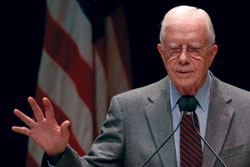
Former U.S. President and Nobel Peace
Prize winner Jimmy Carter
All photos by Jessica McConnell
|

|
Three national leaders spoke about issues
in the Middle East and the crucial roles
their countries play in the current international
climate during separate visits to GW in
September and March.
Before a packed audience at GW’s
Dorothy Betts Marvin Theatre on Sept. 22,
Pakistan President Pervez Musharraf outlined
the ways in which his administration has
transformed the country to what he calls
a “modern, progressive society”
dedicated to helping the free world fight
terrorism.
Hamid Karzai, president of Afghanistan,
also highlighted international relationships
in his Sept. 26 speech at the Jack Morton
Auditorium by focusing on Afghan-U.S. commerce
and the embattled nation’s economic
challenges and opportunities.
And former U.S. President Jimmy Carter
drew a packed audience to Lisner Auditorium
on March 8 to discuss his controversial
book Palestine: Peace Not Apartheid.
Carter, a Nobel Peace Prize winner, underscored
the necessity of increasing debate on the
Israeli-Palestinian conflict and the urgency
of reinstating peace talks.
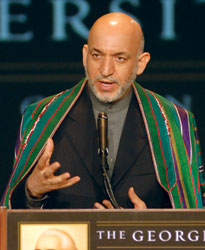
Afghanistan President Hamid Karzai |
|
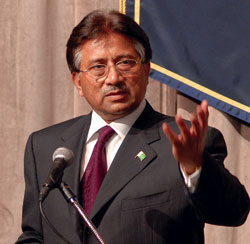 Pakistan
President Pervez Musharraf Pakistan
President Pervez Musharraf
|
|
In Partnership Project,
GW Plans New Residence Hall

|

Construction on GW’s
474-bed undergraduate residence hall begins
this summer.
|
GW and D.C. Public Schools are celebrating the
approval of a joint Planned Unit Development that
allows GW to build a new 474-bed undergraduate
residence hall on the Foggy Bottom Campus.
The project—which was approved by the D.C.
Zoning Commission in November—expands upon
the existing programmatic partnership between
GW and School Without Walls, a nontraditional
D.C. public high school that is located on G Street
within the Foggy Bottom Campus.
Under the GW/DCPS agreement, GW will purchase
from DCPS a small parcel of land fronting F Street
as well as development rights generated through
rezoning the GW and DCPS parcels, for a sum of
approximately $12 million.
GW will combine the newly acquired land with
its adjacent tennis courts to build an approximately
200,000 square foot residence hall which will
feature apartment-style units and accommodate
approximately 178 vehicles in an underground parking
garage. SWW will use the funds from GW, and additional
funds allocated by DCPS, to modernize the existing
SWW building, and build an addition that offers
additional classrooms, a media center, and a rooftop
terrace.
Both projects are scheduled to begin in 2007
and be completed in 2009.
“The commission’s decision is a significant
milestone for the School Without Walls and GW,
bringing much needed renovation to a public high
school building that sorely needs it while allowing
the development of new on-campus housing for the
University. GW’s partnership with the school
and DCPS is truly a model for public private partnerships
in the District. Further, GW’s new residence
hall will help us continue to meet on-campus housing
requirements, as well as provide students with
apartment-style housing options,” says GW
President Stephen Joel Trachtenberg.
GW and School Without Walls have worked together
on other projects over the past two decades, including
sharing classroom space and providing internships
for GW’s education students.

GW’s 20-Year
Foggy Bottom Campus Plan Approved

The former GW Hospital site, called Square
54, is slated for a mixed-use project of
apartments, shops, and office space.
|

|
The D.C. Zoning Commission in March unanimously
approved GW’s 20-year Campus Plan, which
sets forth a vision for the future of the Foggy
Bottom Campus in the context of its surrounding
neighborhoods.
The proposal, which is the culmination of nearly
two years of community-based planning, employs
a “Grow Up, Not Out” strategy aimed
at concentrating development at the core of GW’s
Foggy Bottom Campus. It allows for the construction
of new University academic facilities, additional
undergraduate student housing, and a dynamic I
Street retail corridor, as well as enhancements
to streetscapes and open spaces.
“I offer sincere thanks to the more than
100 neighbors, students, faculty, staff, alumni,
and civic and business leaders who provided testimony
in support of the plan, to all community members
who participated in the two-year planning process,
and to the D.C. Office of Planning and other city
agencies involved in this effort,” GW President
Stephen Joel Trachtenberg says. “The collaboration
of these stakeholders greatly contributed to the
well-reasoned and comprehensive Campus Plan presented
by GW.”
The plan also provides several community and
District-wide amenities, including the implementation
of environmentally sensitive planning and design
principles, and the preservation of historic resources
through a proposed historic district—the
first of its kind for a D.C. university. In addition,
the University has agreed to maintain existing
caps on campus student and faculty/staff populations
and has committed to new limitations on the acquisition
and future use of off-campus properties.

|

The Campus Plan sets
forth a vision for the future of the Foggy
Bottom Campus, including enhancing the academic
heart of the campus. This is a rendering
of H Street and Gelman Library.
|
“Students are very excited about the future
enhancements, especially the planned science center,
which will result from this Campus Plan,”
says Gina Fernandes, a junior and GW Student Association
vice president for community affairs. “The
students have been actively engaged in the planning
process—attending community meetings and
the hearings and providing testimony—because
we are investing in the future of the University.”
Also before the Zoning Commission is GW’s
proposal for redevelopment of Square 54, the former
GW Hospital site, as a mixed-use “town center”
with office, residential, and retail. The 2.6-acre
vacant lot is slated to include 85,000 square
feet of retail space including a grocery store,
approximately 330 apartments, and 440,000 square
feet of office space.
The Square 54 project received preliminary approval
from the D.C. Zoning Commission in March and will
go to the National Capital Planning Commission
in May for review and comment with respect to
issues related to federal interests. It will then
be scheduled for final Zoning Commission action.
The Campus Plan and Square 54—along with
the recently approved joint D.C. Public Schools/GW
School Without Walls project—are all part
of the University’s integrated campus development
strategy aimed at furthering GW as a world-class
research University in the nation’s capital.
For more information, visit www.neighborhood.gwu.edu.

GW Targets $4.5 Million
Toward Academic Excellence
The new year started on an exciting note at GW,
with the University announcing the selection of
eight new academic signature programs and five
strategic initiatives earmarked to receive substantial
funding during the next several years, thanks
to a Board of Trustees-approved $4.5 million special
endowment payout. GW’s latest round of targeted
program investment comes on the heels of a highly
successful, multiyear initiative launched in 2003
providing valuable support to seven signature
programs.
Part of the University’s Strategic Plan
for Academic Excellence, the funding aims to “catapult
GW to a new level,” says Donald R. Lehman,
executive vice president for academic affairs,
who oversaw the rigorous selection process. “We
received an outstanding group of proposals from
across the disciplines,” he says. “In
all evaluations, the bulk of the emphasis was
placed on whether the proposed investment would
improve educational quality and enhance research
in areas meaningful to our faculty and students
and of importance to society, while enhancing
the University’s prestige and reputation.”
All candidates were also required to identify
substantial matching funds from their own budgets.
Thirteen proposals emerged victorious—eight
submitted by faculty members and five directly
by the deans. The winning deans’ proposals—funded
as strategic initiatives—will pump additional
funds into the University Writing Program, language
instruction, international initiatives, a new
state-of-the-art electronic classroom in GW’s
Gelman Library, and podcasting. The eight selected
faculty proposals—coined the new signature
programs—are Discovering and Interpreting
the Diversity of Life, Urban Inequality, Systems
Biology, Doctoral Study in Special Education,
Institute for Corporate Responsibility, Institute
for Integrating Statistics in Decision Sciences,
Center for Biomimetics and Bioinspired Engineering,
and High Performance Computing Technology and
Applications.
The deans’ strategic initiatives spotlight
some of the hottest topics in academia today.
A dozen GW classrooms are now podcast enabled
through Colonial Cast, sponsored by GW’s
Academic Technologies in conjunction with Apple
Computer’s iTunes U, which provides students
with access to lectures and related videos 24/7
on their iPods, MP3 players, and personal computers.
GW is poised to catapult to the forefront of foreign
language instruction through Columbian College
of Arts and Sciences’ language instruction
initiative. Funds will help bolster language instruction
at GW by creating a technology-based language
center and adding 15 foreign language faculty
members specializing in Arabic, Chinese, French,
Hebrew, Japanese, Korean, Spanish, and American
Sign Language. “High-level foreign language
instruction is critical to providing a top-notch
undergraduate education at GW as a global university
delivering core competencies,” Lehman says.
International initiatives also received top billing
among endowment-funded programs, with the Elliott
School of International Affairs receiving money
to strengthen graduate education, research, engagement,
and advancement. The funds also will support the
launch of two new research institutes—focused
on the Middle East and on international security
and conflict—and a signature lecture series
analyzing topics such as the future of democracy.
Funding devoted to the new signature programs
will help establish and advance a number of innovative
centers and institutes at GW, including the Center
for Biomimetics and Bioinspired Engineering, the
Institute for Corporate Responsibility, the Institute
for Integrating Statistics in Decision Sciences,
and the Institute for Massively Parallel Applications
and Computing Technology, focusing on high-performance
computing.
This year, $2.4 million of the special endowment
funds will be allocated, shored up by matching
funds of nearly $1.9 million. The remaining $2.1
million will be targeted toward strategic hires
of senior faculty members beginning in the fall.
“Selective hiring of top faculty in our
areas of strength will add stature, depth, and
visibility to our programs,” Lehman says.
In the meantime, GW’s seven original signature
programs, now in their fifth year of funding,
are flourishing. To date, GW has invested more
than $7.8 million in the programs, including nearly
$2.3 million this year alone. “The funding
has had a tremendous impact,” says Lehman,
noting that the targeted programs have seen substantial
increases in outside research funding, improved
student quality and selectivity, and enhanced
educational and research opportunities for students.
“Selective excellence is ultimately about
building prestige and propelling GW into the ranks
of top-tier research institutions,” Lehman
explains. “These types of high-impact investments
pay off, as shown by the strength of our seven
original signature programs. Thanks to the many
things we’ve accomplished over the past
20 years under President Trachtenberg, we’re
poised to become one of the nation’s preeminent
research universities. It’s an exciting
time for GW.”
—Jamie L. Freedman

|
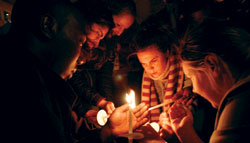
Jessica McConnell
|
Standing Strong For Virginia Tech
With heavy hearts, the GW community came
together for a candlelight vigil to show
support for Virginia Tech and mourn the
more than 30 victims of the tragic campus
shootings. Some students shared stories
of friends or loved ones who attend the
university in Blacksburg, Va. Others reflected
on the tragedy or offered prayers. Nearly
400 people gathered at the vigil in Kogan
Plaza on April 17, the flickering candlelight
illuminating the colors of their clothing
into a solid sea of maroon and orange. |

Historical Bank Records
Move to GW

Thick, dusty books hold the financial statements
of some of Washington’s key historical
players, including 23 presidents. The Riggs
Bank archives were donated to Gelman Library
from the PNC Financial Services Group and
will be on display through May.
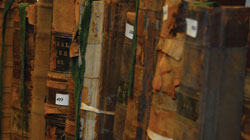 Photos by Jessica
McConnell
Photos by Jessica
McConnell
|

|
Some of the country’s most prominent and
patriotic figures, including Abraham Lincoln,
Francis Scott Key, and Susan B. Anthony, will
have their penny-by-penny financial records preserved
in a new collection at Gelman Library.
The PNC Financial Services Group Inc. donated
the Riggs Bank archives—valued at $5.2 million—to
GW last fall to ensure the records will be well
cared for and accessible to future generations.
The thick, deteriorating leather-bound books
date from the early 1800s to the 1940s and include
the ledgers of 23 presidents, numerous congressmen,
and other notable American personas, such as antebellum
statesman Daniel Webster and Red Cross organizer
Clara Barton.
The archives are on formal display at the library
through May.
Handwritten but in good condition, the records
expand the University’s existing collections
on Washington, D.C.’s political, economic,
social, and cultural history.
“The research potential provided by these
records will be invaluable to any scholar interested
in [the city’s] commercial history,”
says Michael N. Harreld, PNC Bank regional president.
The books will be part of the library’s
Washingtonia collection, which includes records
from Riggs Bank, National Bank of Washington,
Farmers and Mechanics Bank, Lincoln National Bank,
and Washington Loan & Trust. It documents
the day-to-day operations of the institutions
and their influence on the economic life of the
nation’s capital.
Phil Raino, exhibits specialist at the library,
says the newest set of archives have been transferred
from the bank’s D.C. office to the library
in special acid-free paper to preserve the integrity
of the pieces. The PNC Foundation gave the library
$125,000 to assist in the move, preparation, and
installation of the gift.
While the collection may appear to be dusty old
books, they still play a major role in piecing
together a part of the country’s past. Just
don’t expect any scandals.
“There’s nothing overly revealing,”
Raino says.

Alumna Marguerite Barratt
Named Columbian College Dean

|
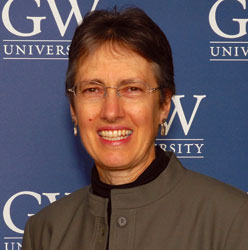
Jessica McConnell
|
A GW alumna is returning to the campus this summer
as head of the University’s academic cornerstone.
Dr. Marguerite Barratt, M.Phil ’78, will
become dean of GW’s Columbian College of
Arts and Sciences on Aug. 1, replacing Interim
Dean Diana Lipscomb.
Barratt, an accomplished expert on developmental
psychology, is currently the deputy director of
clinical research policy analysis and coordination
at the National Institutes of Health in Bethesda,
Md. As dean, she hopes to build onto the college’s
already solid foundation, she says.
“GW’s prominence as a magnet for
public policy learning and research and its record
of training students for professional work, along
with its notable faculty, are among the reasons
I am eager to join this preeminent institution,”
Barratt says.
Prior to her post at NIH, Barratt was division
director for behavioral and cognitive sciences
at the National Science Foundation, where she
also served as the human subjects research officer.
A leader in both public service and the classroom,
Barratt will bring 30 years of research and teaching
experience to GW in the parent-child interaction
area, with a focus on naturalistic field work
and attention to specialized populations.
GW President Stephen Joel Trachtenberg says Barratt’s
extensive experience in research, teaching, fundraising,
and management will “allow the school to
continue to grow in prominence in its research
and education mission…as well as capitalize
on GW’s numerous academic strengths with
the arts and sciences.”
The Columbian College is made up of 42 departments
and programs, encompassing the humanities, sciences,
mathematics, fine arts, and social sciences.

Jazz Band Showcases
That Swing
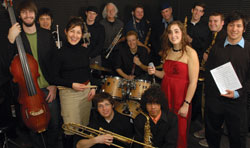 Jessica McConnell
Jessica McConnell
|

|
From a small basement classroom on GW’s
campus, the sound of blaring horns, chirping piano
keys, and bellowing bass combine classic 1930s
jazz with college cool.
“Immerse yourself in it,” director
James Levy, B.Mus. ’83, tells the group.
“Let it evolve.”
Like its foot-tapping jam sessions, King James
and the Serfs of Swing—GW’s 13-piece
student jazz band—has blended into the campus
community’s musical scene over the past
decade. Now they’re ready to take center
stage.
In April, the group performed at Blues Alley,
the legendary Washington jazz club that has hosted
American music icons over the past 40 years like
Eva Cassidy and Dizzy Gillespie. The gig, coupled
in the same month with an all-day, outdoor “Big
Band Jam” on the National Mall, was an effort
by Blues Alley’s nonprofit organization
to showcase talented youth. GW was one of nine
universities from around the nation that participated.
With roots firmly planted in the timeless sounds
of 1930s jazz, King James and the Serfs of Swing
was a natural choice for the shows, says Harry
Schnipper, executive director of Blues Alley.
“GW has yet to be platformed as a major
contributor to Washington, D.C., jazz,”
Schnipper says. “We feel the time is right
to raise the level.”
While performing at Blues Alley is considered
a big time opportunity for GW’s band, the
group has long had a tradition of jamming out
at campus concerts and special events.
“King” Levy, an adjunct assistant
professor who took over the University’s
jazz band and formed the Serfs in 1991, says the
group’s ability to improvise and blend their
sounds sets them apart from the sheet-music type.
“Jazz is based largely on playing by ear.
It’s interactive,” Levy says. “There
are large spaces in the middle of songs that they
have to create as a group. That’s when they
find how they fit in.”
Levy is no stranger to swing, either. He began
playing music professionally at age 16 and has
presented several of his music compositions at
the National Cathedral. As a faculty member since
1984, Levy started the Department of Music’s
jazz program and is the pianist in the GW Faculty
Jazz Quintet, a group that hosts jazz jam session
every Friday on campus.
This past spring, Levy prepared the Serfs with
practice, practice, practice to transition from
thumping band sessions in a crowded basement classroom
to the spotlight performance on a world-renowned
stage.
The audition-only group, which is made up mostly
of nonmusic majors, performs with an emphasis
on Count Basie and Duke Ellington’s styles.
And like Washington, D.C., native Ellington, the
band took on a name with nobility in the title.
After all, when they play, they feel a bit like
royalty.
“This isn’t just about the performance,
but about the growth we’ve made to get there,”
says vocalist and GW junior Arielle Goodman. Playing
at Blues Alley was “the cherry on top,”
she says.
—Jaime Ciavarra
A ‘Signature
of Loudoun’
The Loudoun County Economic Department
Design Cabinet awarded GW’s first
building at the Virginia Campus a “Signature
of Loudoun” Design Excellence Award.
The design program identifies and honors
those structures, interiors, places, and
details that, together, make Loudoun County
unlike any other. There were nine winners
in six categories. Award certificates and
posters of the winning designs were presented
to President Stephen Joel Trachtenberg and
to the primary architect, Philip Esocoff. |
Colonials in Congress
With a campus in the heart of the nation’s
capital, GW has always attracted students interested
in politics. It should come as no surprise then
that 14 alumni have returned to Washington, D.C.,
this year as members of the U.S. Congress. From
delegate of a U.S. territory to Senate majority
leader, these officials are making an impact on
a global scale. Here is the impressive list of
our congressional leaders:
Rep. Jason Altmire, MHSA ’98,
(D-Dist. 4) of Pennsylvania
Rep. Eric Cantor, BA ’85,
(R-Dist. 7) of Virginia
Del. Donna Christensen, MD ’70,
(D) of the U.S. Virgin Islands
Sen. Kent Conrad, MBA ’75,
(D) of North Dakota
Rep. John Duncan, JD ’73,
(R-Dist. 2) of Tennessee
Sen. Michael Enzi, BBA ’66,
(R) of Wyoming
Sen. Daniel Inouye, JD ’52,
(D) of Hawaii
Rep. Steve Israel, BA ’81,
(D-Dist. 2) of New York
Rep. Sam Johnson, MSIA ’74,
(R-Dist. 3) of Texas
Rep. Tim Mahoney, MBA ’83,
(D-Dist. 16) of Florida
Rep. Jim Ramstad, JD ’73,
(R-Dist. 3) of Minnesota
Sen. Harry Reid, JD ’64,
(D) of Nevada
Rep. Cliff Stearns, BS ’63,
(R-Dist. 6) of Florida
Rep. Robert Wexler, JD ’85,
(D-Dist. 19) of Florida
Nurturing
the Flock
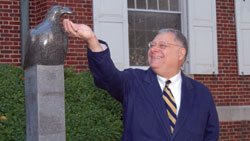 Jessica McConnell
Jessica McConnell
|

|
GW’s urban campus is now home to
a few rare birds. Above, President Trachtenberg
jests alongside “The Raven,”
a nearly 6-foot tall, 500-pound stone bird
statue that sits outside Old Main Building
on F Street. Dedicated on Edgar Allan Poe’s
birthday, the smooth black figure is the
most recent addition to GW’s four
avian landmarks.
Want to find the other feathered friends?
Stroll past the hawk on the southeast corner
of University Yard; gander at the hawk on
the Mount Vernon Campus in front of Eckles
Library; and pause near the eagle, memorializing
9/11, on Eye Street near the West End apartment
building.
Students say the public art helps punctuate
the campus.
“[GW] is identified not just by the
buildings we enter, but by the landmarks
we pass along our way,” Junior Maggie
Desmond said at the bird’s dedication.
The sculptures, created by Martha’s
Vineyard-based artist Benjamin Cabot, were
purchased and installed at the University
over the past six years. |
VA Campus Hosts High
Schoolers
Faculty members of the GW Virginia Campus led
approximately 120 high school students from Loudoun
County Public High Schools through nine workshops
during the campus’ first Engineering and
Technology Day to illustrate different careers.
The workshops included building a 20-foot modular
bridge, digitizing a crash test dummy, creating
an electrical circuit, testing driving skills,
and tracking computer hackers. Participants also
experimented with computer animating and digital
media, experienced a simulated earthquake, learned
how technology contributes to crisis management,
and learned how to separate fact from fabrication
during accident investigation.
The event was so successful that it will now
occur annually.
Re-spoutin’ the Fountain

|
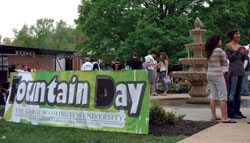
Jessica
McConnell
|
More than a thousand students celebrated
the arrival of spring during Fountain Day
on the Mount Vernon Campus, an annual event
that spotlights live music, tasty food,
and the traditional re-start of the campus’
water-flowing, four-tiered fountain.
This year’s theme, “Turning
on Awareness,” was centered on political
and environmental issues championed by GW’s
student groups. Activities included a tree
planting sponsored by Green GW, voter registration
sponsored by the College Democrats and College
Republicans, and a mock refugee camp sponsored
by GW STAND.
In between T-shirt dyeing and Henna tattoo
stations, students rocked out to performances
by Ben Kweller, Derek James, and Jukebox
the Ghost, a GW student band. The free event,
which was held April 28, has been a traditional
spring kick-off since 1999.
|
|